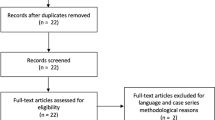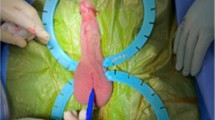Abstract
Penile curvature is a common urological disease. Tunical plication for correction of penile curvature has been much popularized being simpler, adjustable to avoid overcorrection, less bleeding, and less postoperative erectile dysfunction. This study aims to assess the results of modified 16-dot plication technique for correction of congenital and acquired penile curvature and avoidance of knot-associated complications. Eighteen patients underwent correction of their penile curvature using the modified 16-dot plication technique between January 2014 and October 2015. Patients’ pre and postoperative data were analyzed. The mean age of patients is 44 years old. Of the patients 15 who were available for follow-up, 8 patients had congenital penile curvature (CPC) and 7 had Peyronie’s disease (PD). The angle of deviation ranged from 30° to 90°. Erectile function (EF) was assessed preoperative by IIEF score and duplex ultrasound. Postoperative follow-up at 3 and 6 months revealed straight erect penis in all patients. Longer follow-up at 1 to 2 years, 2 patients complained from slight recurrence of curve (<20°) and 2 patients complained of worsening of their erectile function. Penile shortening was noted by 6 patients. None of our patients stated any knot complication or bothersome, nor do hematomas, numbness, or painful erections. The modified 16-dot plication technique for correction if penile curvature is a safe and effective method. This modification allowed the knots to be tucked in the plicate tunical tissue avoiding knot-associated complications. More investigation on a large scale of patients or multicenter studies is recommended.
This is a preview of subscription content, access via your institution
Access options
Subscribe to this journal
Receive 8 print issues and online access
$259.00 per year
only $32.38 per issue
Buy this article
- Purchase on Springer Link
- Instant access to full article PDF
Prices may be subject to local taxes which are calculated during checkout


Similar content being viewed by others
References
Ebbehoj J, Metz P. Congenital penile angulation. Br J Urol. 1987;60:264–6.
Lee SS, Meng E, Chuang FP, Yen CY, Chang SY, Yu DS, et al. Congenital penile curvature: long-term results of operative treatment using the plication procedure. Asian J Androl. 2004;6:273–6.
Nesbit RM. Congenital curvature of the phallus: report of three cases with description of corrective operation. J Urol. 1965;93:230–2.
Baskin LS, Lue TF. The correction of congenital penile curvature in young men. Br J Urol. 1998;81:895–9.
Thiounn N, Missirliu A, Zerbib M. Magalie Larrouy: corporeal plication for surgical correction of penile curvature. Experience with 60 patients. Eur Urol. 1998;33:401–4.
Gholami SS, Lue TF. Correction of penile curvature using the 16-dot plication technique: a review of 132 patients. J Urol. 2002;167:2066–9.
Cordon BH, Sundaram V, Hofer MD, Kavoussi Nl, Scott JM, Morey AF. Penile plication as salvage strategy for refractory Peyronie’s disease deformities. Urol Pract. 2017;4:149–154.
Schneider T, Sperling H, Schenck M, Schneider U, Rubben H. Treatment of penile curvature—how to combine the advantages of simple plication and the Nesbit-procedure by superficial excision of the tunica albuginea. World J Urol. 2003;20:350.
Van Der Horst C, Martinez Portillo FJ, Seif C, Alken P, Juenemann KP. Treatment of penile curvature with Essed-Schroder tunical plication: aspects of quality of life from the patient’s perspective. BJU Int. 2004;93:105.
Syed AH, Abbasi Z, Hargreave TB. Nesbit procedure for disabling Peyronie’s curvature: a median follow-up of 84 months. Urology. 2003;61:999.
Shin SH, Jeong HG, Park JJ, Chae JY, Kim JW, Oh MM, Hong, et al. The outcome of multiple slit on plaque with plication technique for the treatment of Peyronie’s disease. World J Men Health. 2016;34:20–27.
Poulsen J, Kirkeby HJ. Treatment of penile curvature—a retrospective study of 175 patients operated with plication of the tunica albuginea or with the Nesbit procedure. Br J Urol. 1995;75:370–4.
Nooter RI, Bosch JL, Schroder FH. Peyronie’s disease and congenital penile curvature: long-term results of operative treatment with the plication procedure. Br J Urol. 1994;74:497.
Tariq Osman. Abbas: hypospadias surgery update; current trends in the correction of penile Curvature. Moj Surg. 2015;2920:00012.
Hsieh J-T, Liu S-P, Chen Y, Chang H-C, Yu H-J, Chen C-H. Correction of congenital penile curvature using modified tunical plication with absorbable sutures: the long-term outcome and patient satisfaction. Eur Urol. 2007;52:261–267.
Shefi S, Pinthus JH, Mor Y, Raviv G, Ramon J, Hanani: JI. To bury the knot, then, is better than not. Urology. 2008;71:1206–1208.
Author information
Authors and Affiliations
Corresponding author
Ethics declarations
Conflict of interest
The authors declare that they have no conflict of interest.
Rights and permissions
About this article
Cite this article
Salem, E.A. Modified 16-Dot plication technique for correction of penile curvature: prevention of knot-related complications. Int J Impot Res 30, 117–121 (2018). https://doi.org/10.1038/s41443-018-0018-6
Received:
Revised:
Accepted:
Published:
Issue Date:
DOI: https://doi.org/10.1038/s41443-018-0018-6
This article is cited by
-
Penile Plication in Peyronie’s Disease: Technique Evolution and Recent Advances
Current Sexual Health Reports (2021)
-
Plication techniques in Peyronie’s disease: new developments
International Journal of Impotence Research (2020)
-
Clinical characteristics and surgical outcomes in men undergoing tunica albuginea plication for congenital penile curvature who present with worsening penile deformity
World Journal of Urology (2020)
-
Long-term outcome after grafting with small intestinal submucosa and collagen fleece in patients with Peyronie's disease: a matched pair analysis
International Journal of Impotence Research (2019)
-
Introducing the ventral sealing technique using collagen fleece for surgical therapy of patients with ventral Peyronie’s curvature: initial experience
International Journal of Impotence Research (2018)



